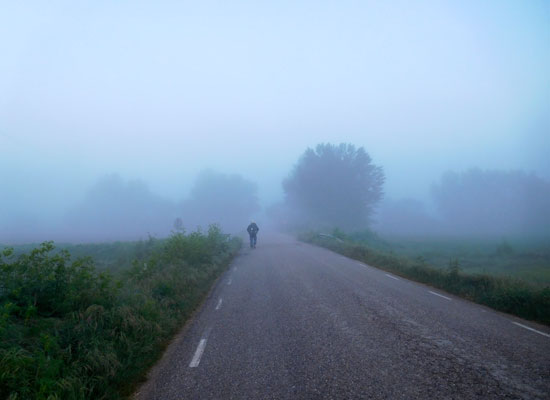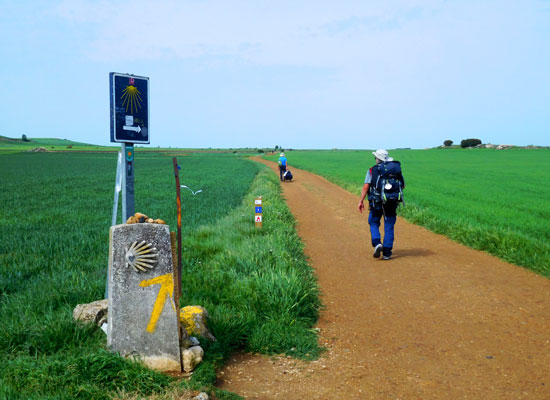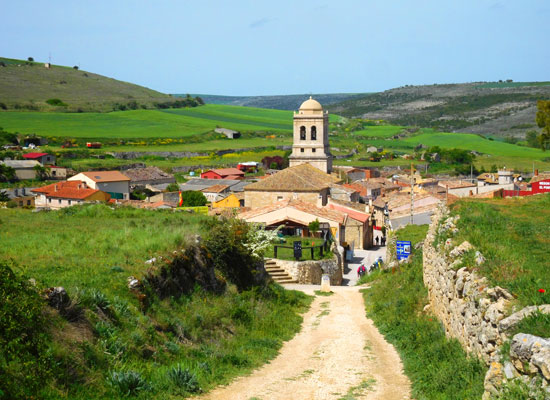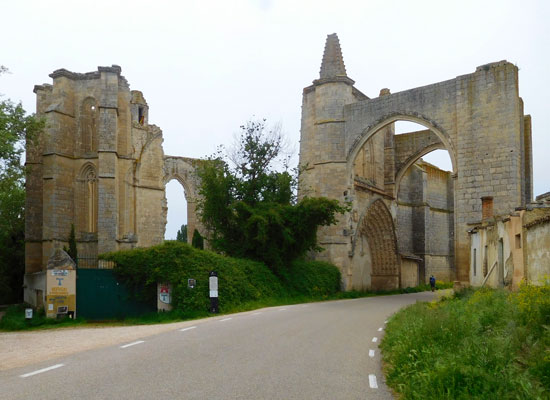Step by Step on The Way of Saint James
From Tardajos to Castrojeriz
24 May 2018
Stage 14 – 29 km

Today's stage will be slightly longer than average—about thirty kilometres.
This morning we woke up fairly early; we want to start ahead of time so we won’t have to rush later in the day.
The couple of “hospitaleros” (as hostel managers are called in Spanish) prepare us a light breakfast with tea, coffee, milk, bread, and jam, which we supplement with the sweets we bought yesterday.
Here, at the municipal hostel in Tardajos, both lodging and breakfast are free of charge—or more accurately, based on the usual “donation” system.
For this reason, at the hostel entrance, hanging on the wall, there’s a small box similar to a post box, decorated with a naïve-style landscape painting and the words “Ayuda para el albergue.”
Donations are not handed directly to the “hospitaleros” but placed in the box, allowing everyone to give as much as they see fit while keeping their contributions anonymous.
Personally, I slip a €10 note into the box, roughly equivalent to what one would typically pay elsewhere for lodging and breakfast.
At 6:30, we leave the hostel and set off on The Way.
As usual, it’s quite cold, but at least it’s not raining.
Today’s weather novelty is fog.
We cover the first few kilometres through a bucolic landscape, made even more enchanting by the whitish haze enveloping everything.
In the morning silence, the only sound is the crunch of our footsteps on the damp dirt road.
After the first half-hour of walking, Rabé de las Calzadas is the first village we encounter. As we pass through, I pause briefly to take a look at the Iglesia de Santa Marina.
The church, the pride of the local residents, was inaugurated at the end of the 19th century and was built with white stone to give it elegance. However, the oldest element, dating back to the 13th century, is a pointed-arch portal decorated with a saw-tooth pattern and simple columns in the architectural style typical of Cistercian monks.
A bit further on is the small Ermita de la Virgen del Monasterio: this hermitage, built in Renaissance style, gets its name not only because it was erected on the site of an ancient monastery but also because it houses an image of the Virgin found here.
As we leave the small village, we are greeted by a large mural with scenes related to The Way, painted on the brick wall of a huge barn.
From this point, the desert-like area of the “meseta” begins, often referred to in the plural—“mesetas”—because, in reality, some valleys, varying in size, occasionally interrupt the linearity of this flat and desolate region.
Villages and water sources are scarce; for the traveller, the horizon often feels like a void, revealing no destination for many kilometres and hours.
Fortunately, today we are spared the scorching heat that bakes this land for most of the year. A warm spring sun accompanies us, making the scenery magical and the walk pleasant.
Fields of grain, which in summer form an endless yellow sea, are still green at this time of year, blending beautifully with the clear blue sky.
A gentle climb takes us up to a first plateau.
About two kilometres from Rabé de las Calzadas, we come across the Fuente de Prao Torre, a small rest area with tables and benches where we take a break and refill our water supplies.
The temperature is rising, so I take advantage of the stop to shed a few layers of clothing.

We move forward surrounded by endless fields—nothing else in sight ahead, behind, or to the sides.
This first “meseta” is quite kind to us pilgrims, thanks to the mild weather and relatively short distances between villages.
In just under two hours, I reach Hornillos del Camino.
It’s almost half-past nine, and given the early hour at which I had breakfast, I think a snack is in order.
– Perhaps a good tortilla! –
As I struggle towards a bar, whose sign I spot about a hundred metres ahead, I’m already savouring the thought of my treat.
– My mouth is watering. –
Suddenly, however, a group of cyclists materialises behind me—at least eight of them. Some overtake me on the right, others on the left, and all of them dash into the bar, beating me there by a couple of minutes.
They’re likely part of the same team since they’re wearing matching brightly coloured outfits, making them look like a flock of “parrots,” as a friend of mine who cycles mountain stages might say—though he wears ordinary gear.
When I arrive, I find the bar overrun by cyclists, and the poor bartender, the only one behind the counter, is overwhelmed with orders.
Loud and boisterous, they’ve taken over the tables and the counter of the small bar as if no one else existed. Each one has a different request.
They’re Italians, and judging by their unmistakable accents, Sardinians, to be precise.
I wait patiently for my turn, but when I realise it’s going to take a while, I give up and move on, hoping to find another bar a bit further ahead.
The only regret is having seen the tortilla on display and then watched it disappear, slice by slice, into the mouths of the “ravenous” cyclists.
Among “cycle-pilgrims” and “foot-pilgrims,” it’s well known that there isn’t much mutual sympathy, and with this episode affecting me directly, I can now understand why.
I don’t want to generalise, and I’m certain that the vast majority of cyclists are considerate and respectful towards others on The Way of Saint James.
That said, it’s often a small group of “bad apples” that spoils the bunch.
It’s to this small group that I want to speak:
– Dear cyclists, the long road to Santiago de Compostela is not a race track where you can flaunt your physical strength and technical skills in mastering your bikes.
It’s not a competition where the first to arrive wins a prize.
Just because you follow the route doesn’t mean you are truly walking The Way. Ride calmly and without haste, or you won’t be able to appreciate the beauty and charm of the places you pass through—places brimming with history and spirituality.
And let’s not forget that it wouldn’t be called “The Way” if it weren’t meant as a path for walking.
Bear in mind that, in ancient times, bicycles didn’t exist, and most pilgrims travelled on foot or, at most, on the four legs of a mule or a horse, if they were of higher social standing.
Moreover, let me add this: doing The Way at your pace is like doing it at the speed of light compared to those who walk.
There have been times when I’ve spoken to cyclists and had a strange feeling hearing them say that they started that morning from the same place I set out from three days ago. –

By bike, the entire French Way (starting from Saint-Jean-Pied-de-Port) can be completed in thirteen to fifteen stages, or even fewer.
Cyclists typically cover sixty or more kilometres per day.
The Way of Saint James is designed to be walked, and for this reason, some climbs and descents can be challenging for cyclists. Similarly, rocky paths, narrow passages, and various obstacles often force them to dismount and push their bikes.
While I acknowledge the physical effort involved in cycling, it cannot be compared to the fatigue of those who walk—especially considering that walkers’ journeys last more than twice as long as those of cyclists.
To wrap up, speaking again to that small group of cyclists:
– Avoid travelling in large groups; don’t suddenly appear at high speed behind walkers, ringing your bells to demand passage.
Remember that many pilgrims walking along The Way do so with effort, perhaps enduring physical pain, immersed in the silence, absorbed by the beauty of nature, or lost in thought.
Think about when you’re cycling on the road and cars or trucks speed past, honking and polluting the air you breathe deeply right afterward—remember how annoying that is, even though the drivers are unaware of it. –
I say this from personal experience because I also enjoy cycling routes.
So:
– Long live diversity! – and at the same time – Long live respect for everyone! – as shown by the vast majority of Cyclists, those with a capital “C.” –
***
Returning to my journey, after leaving the bar where I couldn’t grab a bite to eat, I continue along Calle Real in Hornillos del Camino. A few hundred metres ahead, I find a small hostel with a refreshment area where I can get a quick snack.
Unfortunately, though, there’s no tortilla.
– What a shame! – I can’t get it out of my mind, and my body craves it to replenish today’s carbs.
The village is tiny, and I don’t think there’s anything else further along. Not wanting to risk going hungry, I settle for a simple chocolate doughnut.
Behind the counter, I’m served by an Italian girl who had previously walked The Way and has now returned to Hornillos del Camino to volunteer at the hostel.
We chat briefly, and she essentially tells me she’s here to “find herself.”
Statements like that often reveal a dissatisfaction with life, frequently stemming from heartbreak, job issues, or something even more personal and profound.
Given the few minutes it takes me to eat my doughnut, I don’t feel it’s appropriate to interrogate her. Instead, I leave her words to my interpretation based on the undertones of her reply.

I resume walking, and after covering another kilometre and a half, I arrive at Hontanas.
It’s precisely midday—I can’t be mistaken because, just as I step into the village, the church bells ring out, almost as if announcing my arrival.
The chimes accompany me until I stand in front of the Iglesia de la Inmaculada Concepción.
The bells are housed in a tall tower that centrally dominates the church’s façade.
The building dates back to the 14th century and is Gothic in style, though over time it has undergone some Neoclassical modifications.
The entrance door is open, so I take the opportunity to have a look inside.
What stands out most is the gilded retablo of the altar, richly carved in Baroque style. However, visitors’ attention is also drawn to a collection of large photographs, arranged in a grid in one corner, featuring faces of figures who preached peace, non-violence, and love for others.
Alongside saints and clergy, there are also famous people such as Mahatma Gandhi, Mother Teresa of Calcutta, and Martin Luther King.
Hontanas is the standard stopover on The Way, where most people rest after Burgos—a stretch of about thirty-two kilometres.
Since we took a shorter stage to Tardajos yesterday, the distance we’ve covered today to reach here is just twenty-one kilometres.
We’re below the daily average, so Rocco, Dante, and I decide not to stop and continue for another eight kilometres to Castrojeriz.
As a result, our break in Hontanas lasts just twenty minutes.
At the village’s edge, a mural of an ancient pilgrim painted on the white wall of a small building wishes all travellers “Buen Camino.” The same mural highlights that from this point, there are still 457 kilometres to Santiago de Compostela.

After another hour of walking, we arrive at San Antón, an uninhabited area where only the ruins of an ancient Antonine monastery remain.
In the Middle Ages, this religious building also served as a hospital, welcoming foreigners and pilgrims, particularly those suffering from what was known as “Saint Anthony’s fire.”
Of the ancient monastery, only a few parts are still standing, including two Gothic arches under which, even today, as in the past, pilgrims heading to Santiago de Compostela pass.
Between the two arches is the entrance to the church, where a series of finely sculpted archivolts remain remarkably well-preserved.
Nowadays, the monastery is privately owned, and a small twelve-bed refuge has been set up within the ruins. It lacks hot water and electricity.
Dinner is communal and eaten by candlelight, and when departing, visitors leave a donation for both food and lodging.
The hostel is very basic, and those who choose to stay overnight do so mainly for the unique charm of the place.
Managing the small hostel is an “alternative” Italian man with a lean physique and a thick white beard.
He’s just a volunteer taking care of the refuge on behalf of the owner.
He tells us that he left Italy almost thirty years ago, is happy living in Spain, and has no intention of returning to his homeland, given all its issues.
When the conversation shifts to Italian politics over the past two decades, since I’m neither interested in debates nor rhetoric, I decide to end the visit, bid him farewell, and continue walking.
Rocco and Dante were tempted to stay overnight at the monastery, but when I told them I wouldn’t be staying, they decided to come with me.
– The place is fascinating, but don’t ask me to give up a hot shower after a day’s walk. That’s the one comfort I won’t compromise on during this experience! –
The landscape that accompanies us over the last three kilometres of today’s stage remains rural, although the route is entirely on asphalt.
Around 15:00, we arrive in Castrojeriz, where we will spend the night.
We encounter some difficulties finding accommodation: the municipal hostel is full, and other places we check also have no availability.
In the end, after wandering around the village—adding another couple of kilometres to today’s journey—we find space at the Casa Nostra hostel, located in a historic building at the start of the main street.
Around six in the evening, we head out for our usual sightseeing walk, although, in a way, we’ve already seen most of the town while searching for a place to stay.
In a grocery store, we buy snacks for tomorrow. At the same time, we also grab some beers and crisps, having an impromptu aperitif while sitting on a bench.
We end the day with dinner at a small restaurant in the centre, where we pay €11 for the “pilgrim’s menu.”
Personally, I order beans with bits of cured meat, grilled salmon (known as “a la plancha”), and vanilla pudding with cream.
Everything served is excellent.
In hindsight, though, I think I may have overdone it with the fats in this meal.
I’m not particularly careful about my diet and tend to follow my cravings. However, with the calories I burn during the day, by evening, I feel like I could even eat the restaurant tables.
| © Aldo Lardizzone 2020 |  |
CREATIVE COMMONS |



